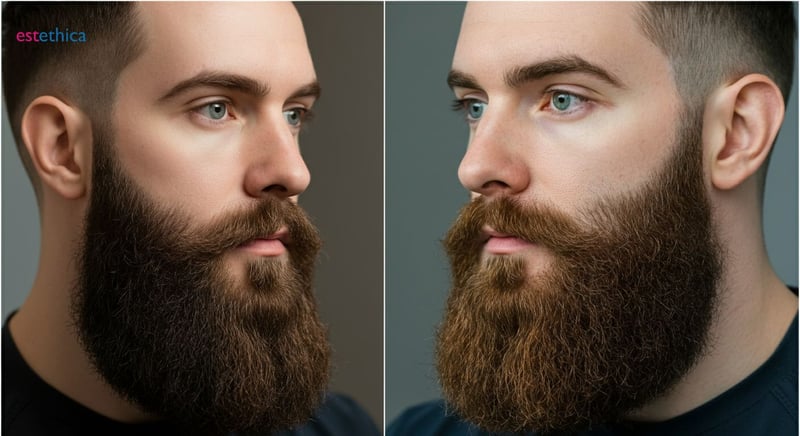Unlocking Beard Transplant Secrets: Transform Your Look
Unlock the hidden potential of your look with expertise in beard transplantation - your path to a thicker, more defined beard starts here!
Transforming your appearance with a beard transplant has become increasingly popular for those seeking a fuller, more defined facial hair look. But what does the procedure entail, and what can you expect before and after undergoing this transformation? In our comprehensive guide, we unlock the secrets behind beard transplants to help you make informed decisions on your journey to enhanced facial aesthetics.
Understanding Beard Transplantation: A Comprehensive Guide
Exploring Beard Transplant Techniques
Beard transplantation is a transformative procedure for those seeking fuller facial hair. The two primary techniques used are Follicular Unit Extraction (FUE) and Direct Hair Implantation (DHI). FUE involves extracting individual hair follicles from a donor area, typically the back of the scalp, and implanting them into the beard region. This method is favored for its minimal scarring and natural-looking results. On the other hand, DHI uses a specialized tool to directly implant hair follicles, offering precise control over the angle and depth of each hair. This technique is ideal for those desiring a more defined beard shape. Both methods have their unique advantages, and the choice often depends on individual preferences and hair characteristics.
Key Benefits of Beard Transplantation
- Enhanced self-esteem through improved facial aesthetics.
- Permanent solution for patchy or sparse facial hair.
- Customizable results tailored to individual facial structure.
These benefits make beard transplantation a popular choice for men looking to enhance their appearance and confidence. For more insights, explore how you can transform your look with beard transplantation.
Understanding the Beard Transplant Process
- Consultation: Discuss goals and assess hair characteristics with a specialist.
- Procedure: Hair follicles are extracted and implanted into the beard area.
- Recovery: Follow post-operative care instructions for optimal healing.
The process is straightforward, with most patients resuming normal activities shortly after the procedure. Understanding each step helps in setting realistic expectations and achieving desired results.

Exploring Best Beard Transplant Methods for Optimal Results
Choosing Between FUE and DHI for Beard Transplants
When considering a beard transplant, selecting the right method is crucial for achieving your desired look. Follicular Unit Extraction (FUE) is renowned for its precision and minimal scarring, making it a top choice for those seeking natural-looking results. This method involves extracting individual hair follicles and implanting them into the beard area, ensuring a seamless blend with existing facial hair.
On the other hand, Direct Hair Implantation (DHI) offers a different approach. This technique allows for the direct insertion of hair follicles without the need for prior incisions, providing a dense and controlled aesthetic outcome. DHI is particularly beneficial for those aiming for a more defined beard shape, as it offers precise control over the angle and depth of each implanted hair.
Factors Influencing Method Selection
- Desired beard density and shape.
- Individual hair characteristics and growth patterns.
- Personal preference for recovery time and scarring.
These factors play a significant role in determining the most suitable beard transplant method for each individual. Consulting with a specialist can help tailor the approach to your specific needs and goals.
Understanding Beard Transplant Costs
- Initial Consultation: Assessing goals and determining the best method.
- Procedure Complexity: Influencing the overall cost based on technique and desired results.
- Post-Procedure Care: Essential for ensuring optimal healing and long-term success.
While cost is an important consideration, the focus should be on the quality of the procedure and the expertise of the clinic. A successful beard transplant can significantly enhance facial aesthetics and confidence, making it a worthwhile investment.

Facial Hair Restoration: What to Expect Before and After
Understanding the Beard Transplant Journey
Embarking on a beard transplant journey begins with a comprehensive consultation. This step is crucial for tailoring the procedure to your unique facial structure and hair characteristics. During this phase, specialists assess your goals and determine the most suitable approach, ensuring a personalized experience.
Post-procedure, patients typically experience mild swelling and the formation of scabs, which are natural parts of the healing process. These initial changes are temporary and pave the way for new hair growth. Within weeks, transplanted follicles begin to produce hair, gradually filling in sparse areas. Over the following months, the beard becomes fuller and more defined, achieving the desired aesthetic.
Factors Influencing Beard Transplant Outcomes
- Individual hair growth patterns and density.
- Adherence to post-operative care instructions.
- Quality of the clinic and expertise of the surgeon.
These factors significantly impact the success of the transplant, emphasizing the importance of choosing a reputable clinic and following recovery guidelines diligently.
Beard Transplant Cost Considerations
- Consultation and planning: Tailoring the procedure to individual needs.
- Procedure specifics: Technique and complexity influencing overall cost.
- Post-procedure care: Ensuring optimal healing and long-term success.
While cost is a consideration, the focus should be on the quality and expertise of the clinic. A successful beard transplant can significantly enhance facial aesthetics and confidence, making it a worthwhile investment.

Is a Beard Transplant Permanent? Debunking Myths
Understanding the Longevity of Beard Transplants
Beard transplants offer a permanent solution for those seeking lasting facial hair enhancement. The transplanted hair follicles, typically sourced from the scalp, are genetically resistant to hair loss. This resistance ensures that once transplanted, the hair will continue to grow naturally, providing a lifelong solution to patchy or sparse beards.
Unlike temporary solutions such as topical treatments or cosmetic fillers, beard transplants integrate seamlessly with existing facial hair. This integration results in a natural appearance that is both durable and aesthetically pleasing. The permanence of the procedure is a significant advantage, eliminating the need for ongoing maintenance or repeated treatments.
Factors Contributing to Permanent Results
- Genetic resistance of scalp hair to loss.
- Proper integration with existing facial hair.
- Expertise of the surgeon in executing the procedure.
These factors collectively ensure the longevity of beard transplants, making them a preferred choice for those seeking a permanent solution to facial hair restoration.
Steps to Ensure Long-Lasting Results
- Choose a reputable clinic with experienced surgeons.
- Follow post-operative care instructions diligently.
- Attend follow-up appointments to monitor progress.
By adhering to these steps, individuals can maximize the success and permanence of their beard transplant, ensuring a lifetime of confidence and enhanced facial aesthetics.
Advanced Beard Transplant Techniques: FUE and DHI
Comprehensive Beard Transplant Process with Optimal Care
Frequently Asked Questions
What are the best beard transplant methods available?
Is a beard transplant permanent?
What should I expect during the beard transplant recovery process?
How do I choose between FUE and DHI for my beard transplant?
What factors influence the cost of a beard transplant?
Discover the path to your healthiest and most beautiful self with estethica's award-winning services. Call now for a free consultation and let our expert team guide you towards a brighter future.
📞 Call for Your Free Consultation Today!